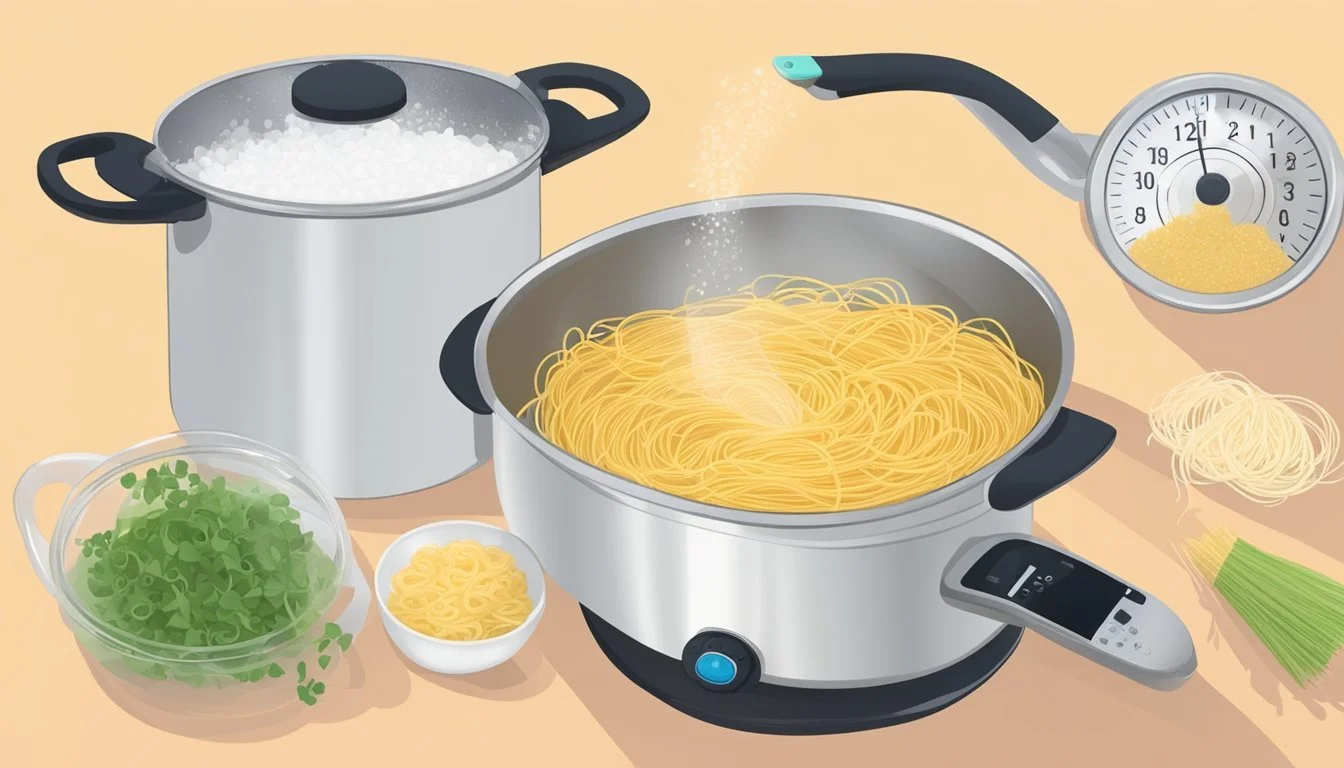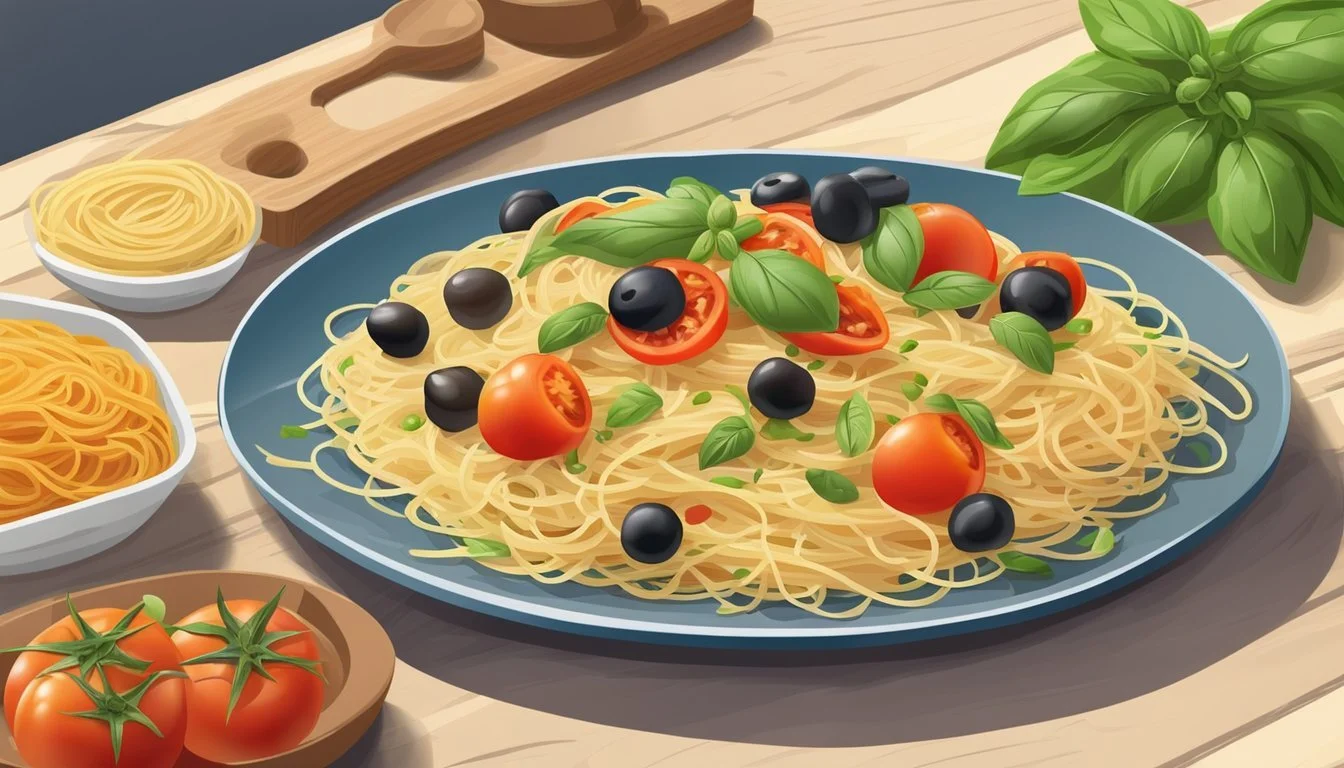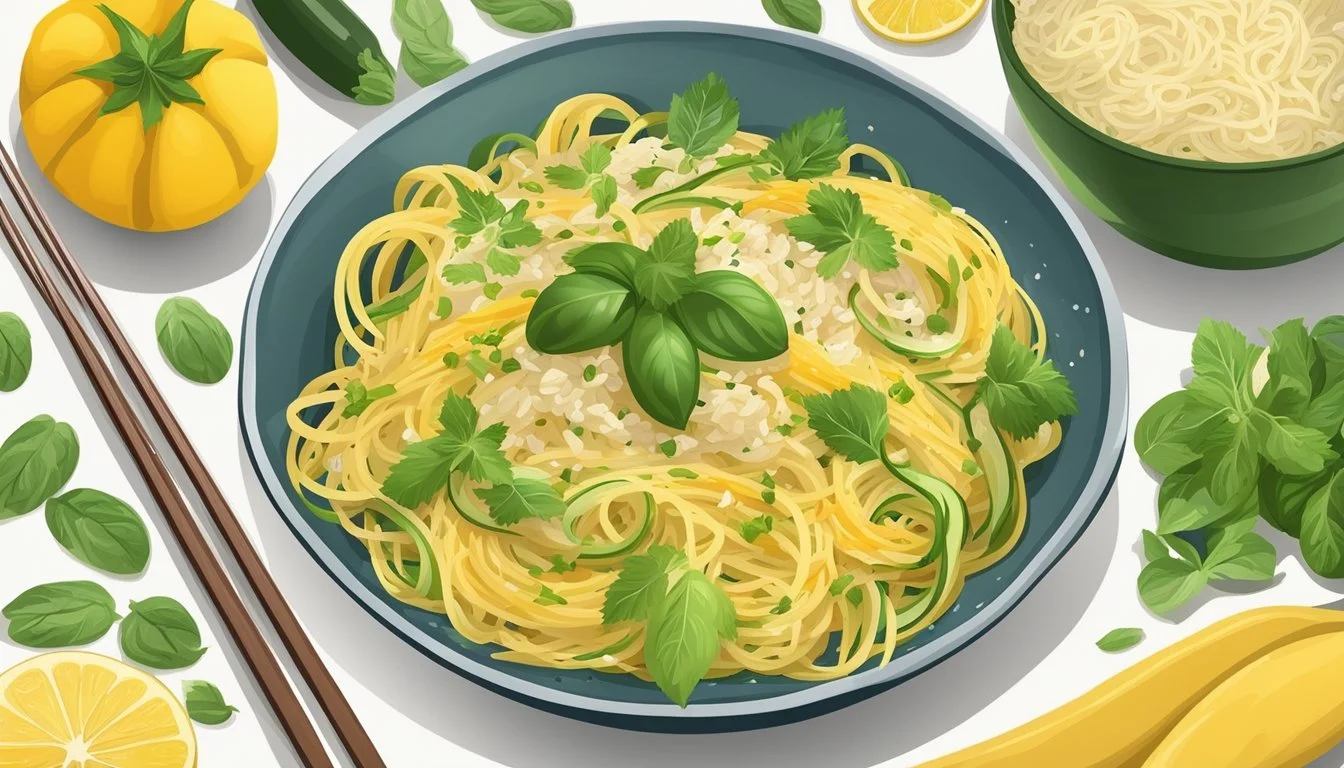Capellini Pasta Substitutes
Top Alternatives for Your Recipes
Capellini pasta, often likened to angel hair pasta (What wine goes well with pasta?) due to their similar appearance, is a staple in Italian cuisine known for its thin strands and quick cooking time. Originating from Italy, both pastas are made from durum wheat flour, which is milled into a granular and slightly yellowish powder called semolina. This type of flour gives the pasta its unique texture and ability to cook quickly, making them a favorite for light and delicate sauce pairings. The difference between the two lies in their diameter; capellini is ever so slightly thicker than the angel hair variant, allowing for a firmer bite, even when al dente.
In the realm of pasta substitutes, those looking to replace capellini are often seeking options that maintain the delicate nature of the original pasta, without compromising on flavor or texture. A proper substitute should be able to mimic the fine strands of capellini and pair well with the traditional, light sauces that define many Italian dishes. With considerations for dietary restrictions or preferences for whole grain options on the rise, substitutes that can offer similar culinary experiences are in demand.
Among various alternatives, whole wheat pastas, rice noodles, and newer introductions to the market like kelp or shirataki noodles provide options for those seeking a different nutritional profile or a gluten-free choice. Each substitute brings a unique texture and cooking requirement to the table, and choosing the proper alternative can depend greatly on the intended dish. It’s essential that these substitutes complement the lightness of sauces typically served with capellini, thereby keeping true to the essence of the original dish.
Understanding Capellini Pasta
Capellini pasta, commonly known as "angel hair" pasta, originated from Italy and is known for its ultra-thin strands made from durum wheat and semolina flour. This section will focus on its characteristics, common culinary pairings, and tips for cooking it to perfection.
Characteristics of Capellini
Capellini is a variety of pasta that is long and very thin, resembling thin strands of hair, which is where the name "little hairs" comes from. Durum wheat, a hard wheat variety, is the primary ingredient, providing a distinct, slightly nutty flavor and a firm texture. When produced with semolina flour, capellini boasts a desirable firmness that can stand up to cooking, achieving the ideal al dente texture. Its diameter measures approximately 0.85mm to 0.92mm, distinguishing it from the even thinner angel hair pasta.
Culinary Uses and Pairings
Traditionally, capellini is best paired with light and delicate sauces that cling to its slender strands without overwhelming them. Simple preparations using olive oil, butter, and a mixture of herbs, or a light tomato sauce work well. For proteins, capellini complements seafood exceptionally well, including shrimp or delicate white fish. In Italian cuisine, it can also be used as a base in soups or salads. When it comes to cheese, parmesan is a suitable choice, adding flavor without excessive weight.
Sauces: Olive oil or butter-based, light tomato sauces
Herbs: Basil, parsley, and chives
Cheese: Grated parmesan or other aged hard cheeses
Proteins: Seafood, particularly shrimp and white fish
Cooking Capellini to Perfection
The cooking time for capellini is brief due to its thinness, generally taking about 2 to 4 minutes in boiling, salted water. It's crucial to constantly taste-test towards the end of cooking to avoid overcooking, which would turn the strands mushy and clumped together. After draining, it's recommended to toss the capellini with a bit of olive oil or butter to prevent sticking and to add a layer of flavor. Serve capellini immediately with the prepared sauce to ensure that the texture remains at its peak.
Cooking Time: Approx. 2-4 minutes
Prevention: Toss with olive oil or butter post-draining
Serving Suggestion: Serve immediately with sauce
Capellini Versus Other Pasta
Capellini pasta, traditionally made from durum wheat flour, is recognized for its thin strands and light texture. This section will compare capellini to other pasta varieties in terms of thickness, flavor, and nutritional content.
Comparing Thickness and Length
Capellini, also known as angel hair pasta, is one of the thinnest pasta forms, with a diameter of about 0.85mm to 0.92mm.
Spaghetti: Slightly thicker with a diameter of approximately 2mm.
Vermicelli: Thin like capellini but typically shorter in length.
Fettuccine: Noticeably wider, flat pasta about 6.5mm in width.
Linguine: Flatter than spaghetti, linguine has a width of roughly 3mm.
When it comes to length, most of these pastas are similar, spanning around 25-30cm long, though vermicelli may vary.
Flavor Profiles and Ingredients
The primary ingredient across these pastas is semolina flour derived from durum wheat, contributing to a mild, slightly nutty taste.
Capellini: Its thin shape absorbs light, delicate sauces well, enhancing subtle flavors.
Spaghetti: Versatile, often paired with a range of sauces from light to hearty.
Vermicelli: Common in stir-fry dishes, it takes on bold flavors, also used in many gluten-free options.
Fettuccine: Its broad shape carries creamier and thicker sauces.
Linguine: Ideal for seafood dishes, it balances the taste between thin and wide pasta.
Nutritional Value Differences
Pasta typically has similar nutritional values, though the portion size can affect the caloric and nutritional intake. Here's a comparison in a cooked 100g serving:
Pasta Type Calories Protein Fiber Capellini ~150 5g 3g Spaghetti ~157 6g 2.5g Vermicelli ~150 5g 1g Fettuccine ~160 5.5g 2.2g Linguine ~161 6g 2.4g
Although differences are minimal, the fiber and protein content can vary. Additionally, gluten-free options may use alternative grains or legumes.
Substitute Options for Capellini Pasta
Capellini pasta, known for its thin, fine strands, can be replaced with a variety of other noodle types and ingredients that cater to different dietary needs and flavor profiles. The following substitutes provide alternatives that maintain a similar mouthfeel or offer a unique twist to the traditional pasta experience.
Rice Noodles and Their Uses
Rice noodles are a great gluten-free option and come closest to mirroring capellini's texture. They absorb flavors well, making them suitable for both warm dishes with sauce or in cold salad preparations. These noodles are commonly used in Asian cuisine and can be found in different widths, with the thinnest version being ideal capellini substitutes.
Zucchini Noodles and Vegetable Alternates
For a nutritious twist, zucchini noodles, also known as "zoodles," are a vegetable substitute offering a lower-calorie and lower-carbohydrate option. Using a spiralizer, zucchini is transformed into noodle-like strands. Other vegetables like spaghetti squash and butternut squash can also be used as substitutes, each bringing a distinct flavor and nutritional profile to the dish.
Quinoa and Grain-Based Substitutes
Grain-based substitutes such as quinoa pasta combine the health benefits of whole grains with the traditional pasta experience. Quinoa pasta is rich in protein and essential amino acids. Its texture is slightly heartier and it holds up well in a variety of recipes, from soups to pasta salads.
Unique Substitutes: Shirataki and Kelp Noodles
Shirataki noodles, made from the konjac plant, and kelp noodles, derived from seaweed, are unique substitutes for capellini. Shirataki noodles are almost calorie-free and have a gelatinous texture, whereas kelp noodles have a slight crunch. Both are mild in flavor, take on the taste of sauces and seasonings well, and are suitable for gluten-free and low-calorie diets.
Selecting Substitutes Based on Sauces and Recipes
When choosing a substitute for capellini pasta, the key is to consider the type of sauce and the overall recipe. Different pasta shapes interact with sauces in unique ways, ensuring that every bite delivers the intended flavor and texture experience.
Light Sauces and Delicate Substitutes
For light sauces such as a simple tomato sauce, pesto, or garlic and oil (aglio e olio), one is best served by selecting delicate pasta substitutes that won't overpower the subtle flavors. Spaghetti is an excellent option; its thin profile is comparable to capellini but offers a slight increase in texture which can still capture the essence of light sauces. Another elegant choice is angel hair pasta, which is similarly thin and can provide an almost identical mouthfeel to that of capellini with light sauces like pomodoro.
Spaghetti: Ideal for light tomato sauces; cook for 8-10 minutes for al dente.
Angel Hair: Perfect for garlic-based or pesto sauces; typically cooks in 2-3 minutes.
Hearty Sauces and Sturdier Substitutes
When the recipe calls for heartier sauces, such as a rich bolognese, creamy alfredo, or carbonara, selecting a sturdier pasta will help to bear the weight and texture of such dense accompaniments. Fettuccine is well-suited for creamy sauces due to its wider, flat shape that holds on to more sauce. In the case of meat-heavy sauces like bolognese or ragu, pappardelle makes an excellent substitute with its broad ribbons, providing ample surface for the sauce to cling to.
Fettuccine: Pair with cream-based sauces; al dente texture achieved in 10-12 minutes.
Pappardelle: Best with thick, meaty sauces; allow for 7-10 minutes cooking time.
Cooking Tips for Pasta Substitutes
Choosing the right substitute for capellini pasta and cooking it properly are critical for maintaining flavor and texture in your dish. Here are some specific cooking tips for ensuring that alternative noodles and ingredients can stand in for traditional pasta successfully.
Avoid Overcooking Delicate Substitutes
Delicate pasta substitutes like rice noodles or spiralized vegetables need careful monitoring as they can quickly become too soft. For spiralized vegetables, it's best to cook until barely tender, typically 1 to 2 minutes. After that, they should be immediately drained to halt the cooking process, ensuring they retain a fine, al dente texture comparable to angel hair pasta.
Rice noodles: Immerse in boiling water for just a few minutes and remove promptly.
Shirataki noodles: Rinse thoroughly and pan-fry or boil for 2-3 minutes.
Pairing Flavors and Textures
The success of a substitute often depends on pairing it with the right sauces and ingredients that complement its unique texture and taste. When replacing capellini, which is a fine noodle, one must consider the weight of the sauce and the specific flavors of the dish.
Kelp noodles: Pair with light, citrus-based sauces.
Brown rice pasta: Works well with robust, hearty sauces.
Modifying Cooking Times for Substitutes
The cooking time for pasta substitutes varies widely, and it's imperative to adjust cooking times based on the specific product. Unlike traditional capellini that typically cooks in 3-5 minutes to achieve al dente, substitutes like brown rice pasta may require more time.
Fettuccine substitutes: Boil for 10-12 minutes.
Spaghetti substitutes: Cook for 8-10 minutes.
Adjustments in cooking time and water amount may also need to be made based on the recipe and stove heat.
Sourcing and Preparing Quality Ingredients
When it comes to making capellini pasta, the quality of ingredients cannot be overstated. They are the foundation of flavor and texture. Ensuring that the best flour and freshest produce and proteins are sourced will elevate the finished dish.
Choosing the Right Flour Type
The choice of flour is crucial in pasta making. Durum wheat flour and semolina flour are traditional choices due to their high protein and gluten content, which gives pasta the desired firmness and ability to hold shape when cooked. Squid ink may be infused into the flour to create a rich, black pasta with a subtle seafood flavor.
Durum Wheat Flour: Ideal for firm and resilient pasta.
Semolina Flour: Provides a rougher texture that clings to sauces.
Squid Ink: Adds a unique color and briny taste.
These flours contribute significantly to texture, and using them ensures an authentic pasta experience.
Selecting Fresh Vegetables and Proteins
Fresh vegetables are paramount for both the pasta dough and the accompanying sauce. Tomatoes and garlic form the base of many traditional sauces, both known for their ability to impart deep flavors. For the freshest taste and highest nutritional content, including fiber, one should choose vegetables from local markets when possible.
Vegetables: Tomatoes, garlic, and lemon, chosen for freshness.
Proteins: Meat, seafood, or cheese, selected based on quality and sustainability.
Adding high-quality olive oil not only enhances flavor but also introduces healthy fats. When it comes to protein, options such as lean meat, seafood, or even a variety of cheeses can complement both the texture and taste profile of the pasta while ensuring the dish is satisfying and balanced.
Capellini in Global Cuisines
Capellini pasta boasts a storied past that spans various cuisines, having been adapted in creative ways to match regional tastes and ingredients.
Italian Roots and Variations
Originating from Italy, capellini, or "little hairs," refers to an ultra-thin, long variety of pasta made traditionally from durum wheat. In Italy, this pasta is a foundation for many dishes, utilizing fresh, local ingredients like pesto, tomato sauce, and alfredo to highlight its delicate texture. Italian chefs often cook capellini al dente and pair it with light sauces to preserve its distinctive mouthfeel.
Capellini in Asian Cuisine
Asian cuisines have embraced capellini as a substitute for traditional noodles such as soba due to its comparable thinness. The pasta's versatility makes it an excellent choice for Asian fusion recipes that might feature a lighter creamy sauce or a robust, flavorful broth. In dishes like Vietnamese pho or Japanese ramen, capellini can be found as an innovative alternative.
Fusion Dishes and New Creations
The versatility of capellini pasta allows it to cross culinary boundaries, leading to new fusion dishes that combine elements from different cooking traditions. Capellini effortlessly becomes the star in recipes where the interplay of textures and flavors is central, sometimes replacing rice noodles in Southeast Asian cuisine or featuring in a pasta dish with a spicy kick, demonstrating its capacity to meld with diverse ingredients.
Pasta and Health: Calories, Carbs, and Considerations
When it comes to pasta, many individuals weigh their love of this staple against its caloric and carbohydrate content, seeking healthier alternatives that align with dietary preferences or restrictions.
Balancing Indulgences and Diet
Traditional capellini, like other pastas, is high in carbohydrates and can contribute significantly to one's daily caloric intake. A single 2-ounce serving of dry capellini typically contains around 200 calories and 42 grams of carbohydrates. However, it provides minimal dietary fiber and protein, affecting its overall nutritional value and satiety level. Individuals managing their weight or blood sugar levels may therefore be inclined to look for substitutes that offer a better balance of calories, carbs, fiber, and protein without sacrificing taste and enjoyment.
Gluten-Free and Low-Carb Options
For those looking for gluten-free alternatives, options such as brown rice pasta and rice noodles can be suitable replacements. Brown rice pasta in particular, not only excludes gluten but also has the benefit of being whole grain, often offering higher levels of fiber and nutrients compared to traditional pasta. A basic comparison of alternative pastas might look like this:
Alternative Pasta Type Approximate Calories (per 1 cup cooked) Carbs (g) Fiber (g) Protein (g) Zucchini Noodles 20 4 1 1.5 Shirataki Noodles 10 3 2 0 Brown Rice Pasta 200 43 2 4 Kelp Noodles 6 1 1 0
Zucchini noodles ('zoodles') and kelp noodles stand out as particularly low in calories and carbs, making them excellent choices for those following low-carbohydrate diets. Shirataki noodles, made from the konjac plant, are high in fiber and very low in calories and carbs, which can be beneficial for weight management and glycemic control.
For an alternative with a similar mouthfeel to pasta but with a lower glycemic index, grain options like orzo made from whole wheat provide a nutritious boost. They typically contain more fiber and protein, which can help in prolonging fullness, thereby aiding in weight management.
By exploring these substitutes, individuals can find ways to enjoy the familiar comfort of pasta dishes while adhering to their personal health goals.
Frequently Asked Questions
What are suitable substitutes for Capellini pasta?
Fettuccine: Thicker, suitable for robust sauces.
Spaghetti: Similar size, more readily available.
Angel Hair: Thinner but comparable; delicate texture.
Gluten-free Options: Rice noodles or brown rice pasta; varies in texture.
How does the cooking time differ for these substitutes?
Fettuccine: Boil for 10-12 minutes; al dente.
Spaghetti: Typically 8-10 minutes; al dente.
Gluten-free Noodles: Follow package instructions, as times vary.
Can leftover Capellini substitute dishes be stored and reheated?
Yes. Store leftovers in an airtight container in the refrigerator. To reheat:
Microwave: Cover with a damp paper towel to avoid overcooking.
Stovetop: Reheat gently with a sprinkle of water or sauce to prevent the noodles from becoming too fragile.
What should one consider regarding the sauce and recipes when using substitutes?
Thickness & Texture: Thicker pasta holds up to heartier sauces.
Fragile Noodles: Delicate noodles pair well with light, thin sauces.
Gluten-free options may require different sauce consistency due to different absorption rates.
How does the nutritional value compare among these substitutes?
It varies:
Durum Wheat Pasta: High in carbohydrates, some protein.
Gluten-free Noodles: Different base ingredients may offer lower carbs or alternative nutritional benefits, like higher fiber content.
What is the recommended diameter for Capellini pasta, and how does it affect cooking?
Capellini: Typically ranges from 0.85mm to 0.95mm in diameter, which allows for a quick cooking time to achieve an al dente texture without becoming overcooked.









